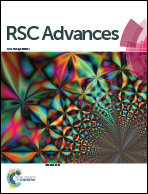Crystallization of poly(ε-caprolactone) in its immiscible blend with polylactide: insight into the role of annealing histories†
Abstract
Polylactide/poly(ε-caprolactone) (PLA/PCL) is a very promising blend material with biodegradable characteristics and tailorable performance because of the good property complementarity between the two components. However, PLA and PCL are asymmetric thermodynamically: PLA has far higher melting point than PCL, and crystallization temperature of PCL is even lower than glass transition temperature of PLA. But this also provides good opportunity to control final structure and properties of PCL/PLA blends through thermal annealing. In this work, two annealing routes were designed to control supermolecular structure of discrete PLA phase in the PCL-rich blends, and the two systems, the blend with discrete amorphous PLA domains and the one with discrete crystallized PLA phase, were obtained. The interfacial property alteration and crystallization behavior of continuous PCL phase were then studied. The results are very interesting. Relative to the amorphous PLA phase, the crystallized PLA domains have better affinity to the continuous PCL phase, showing stronger nucleating effect to the crystallization of PCL and higher impeding effect on the shear flow of blend system. But the presence of discrete PLA phase, whether in crystallized or amorphous state, has no evident influence on the crystal structure and lamellar thickness of PCL. These effects on the crystallization of PCL make the mechanical properties of blends very sensitive to the annealing histories. The blend sample with the crystallized PLA domains shows higher modulus and strength than the one with the amorphous PLA domains, and the values of modulus and strength increase by about 130% and 43%, respectively, relative to the neat PCL. This work provides a facile and green approach to well tailor the supermolecular structure and mechanical properties of the PCL/PLA blends through the simple control of annealing process.


 Please wait while we load your content...
Please wait while we load your content...